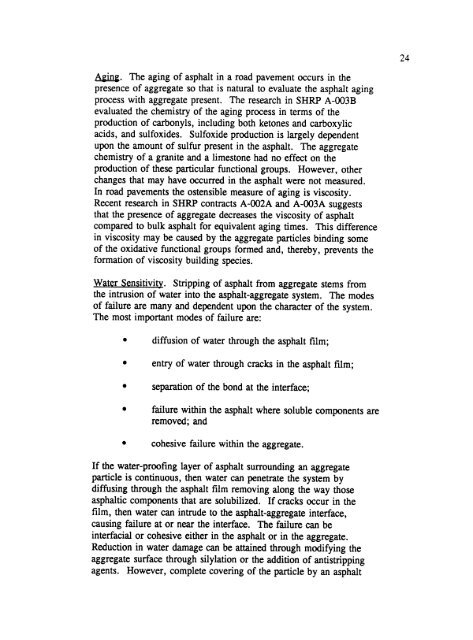Laboratory evaluation of aging for asphalt-aggregate mixtures
Laboratory evaluation of aging for asphalt-aggregate mixtures
Laboratory evaluation of aging for asphalt-aggregate mixtures
Create successful ePaper yourself
Turn your PDF publications into a flip-book with our unique Google optimized e-Paper software.
Aagi . The <strong>aging</strong> <strong>of</strong> <strong>asphalt</strong> in a road pavement occurs in the<br />
presence <strong>of</strong> <strong>aggregate</strong> so that is natural to evaluate the <strong>asphalt</strong> <strong>aging</strong><br />
process with <strong>aggregate</strong> present. The research in SHRP A-003B<br />
evaluated the chemistry <strong>of</strong> the <strong>aging</strong> process in terms <strong>of</strong> the<br />
production <strong>of</strong> carbonyls, including both ketones and carboxylic<br />
acids, and sulfoxides. Sulfoxide production is largely dependent<br />
upon the amount <strong>of</strong> sulfur present in the <strong>asphalt</strong>. The <strong>aggregate</strong><br />
chemistry <strong>of</strong> a granite and a limestone had no effect on the<br />
production <strong>of</strong> these particular functional groups. However, other<br />
changes that may have occurred in the <strong>asphalt</strong> were not measured.<br />
In road pavements the ostensible measure <strong>of</strong> <strong>aging</strong> is viscosity.<br />
Recent research in SHRP contracts A-002A and A-003A suggests<br />
that the presence <strong>of</strong> <strong>aggregate</strong> decreases the viscosity <strong>of</strong> <strong>asphalt</strong><br />
compared to bulk <strong>asphalt</strong> <strong>for</strong> equivalent <strong>aging</strong> times. This difference<br />
in viscosity may be caused by the <strong>aggregate</strong> particles binding some<br />
<strong>of</strong> the oxidative functional groups <strong>for</strong>med and, thereby, prevents the<br />
<strong>for</strong>mation <strong>of</strong> viscosity building species.<br />
Water Sensitivity. Stripping <strong>of</strong> <strong>asphalt</strong> from <strong>aggregate</strong> stems from<br />
the intrusion <strong>of</strong> water into the <strong>asphalt</strong>-<strong>aggregate</strong> system. The modes<br />
<strong>of</strong> failure are many and dependent upon the character <strong>of</strong> the system.<br />
The most important modes <strong>of</strong> failure are:<br />
diffusion <strong>of</strong> water through the <strong>asphalt</strong> film;<br />
entry <strong>of</strong> water through cracks in the <strong>asphalt</strong> film;<br />
separation <strong>of</strong> the bond at the interface;<br />
failure within the <strong>asphalt</strong> where soluble components are<br />
removed; and<br />
cohesive failure within the <strong>aggregate</strong>.<br />
If the water-pro<strong>of</strong>ing layer <strong>of</strong> <strong>asphalt</strong> surrounding an <strong>aggregate</strong><br />
particle is continuous, then water can penetrate the system by<br />
diffusing through the <strong>asphalt</strong> film removing along the way those<br />
<strong>asphalt</strong>ic components that are solubilized. If cracks occur in the<br />
film, then water can intrude to the <strong>asphalt</strong>-<strong>aggregate</strong> interface,<br />
causing failure at or near the interface. The failure can be<br />
interfacial or cohesive either in the <strong>asphalt</strong> or in the <strong>aggregate</strong>.<br />
Reduction in water damage can be attained through modifying the<br />
<strong>aggregate</strong> surface through silylation or the addition <strong>of</strong> antistripping<br />
agents. However, complete covering <strong>of</strong> the particle by an <strong>asphalt</strong><br />
24
















